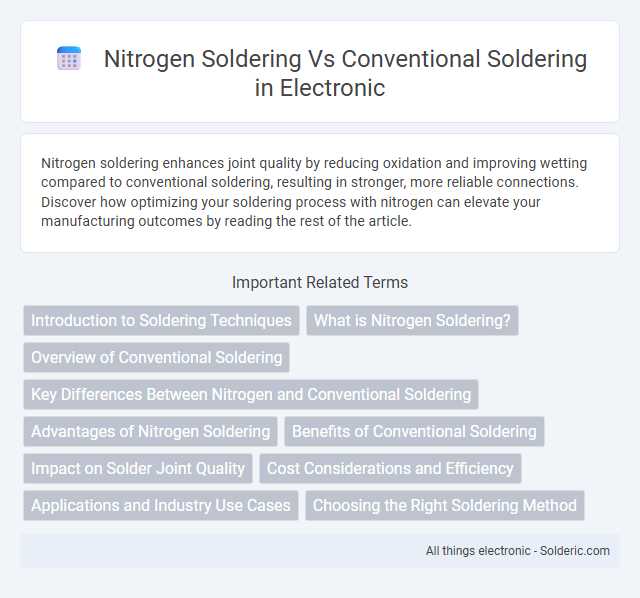Nitrogen soldering enhances joint quality by reducing oxidation and improving wetting compared to conventional soldering, resulting in stronger, more reliable connections. Discover how optimizing your soldering process with nitrogen can elevate your manufacturing outcomes by reading the rest of the article.
Comparison Table
| Aspect | Nitrogen Soldering | Conventional Soldering |
|---|---|---|
| Atmosphere | Inert nitrogen gas environment | Ambient air environment |
| Oxidation | Minimized oxidation, cleaner joints | Higher oxidation, may require flux |
| Flux Usage | Reduced or no flux needed | Requires flux for oxidation control |
| Joint Quality | Stronger, more reliable solder joints | Variable quality, risk of voids and defects |
| Process Speed | Faster due to oxidation control | Slower, dependent on flux efficiency |
| Equipment Cost | Higher due to nitrogen supply systems | Lower, simpler equipment needed |
| Environmental Impact | Lower emissions, less flux residue | Higher emissions, flux residues present |
| Applications | High-reliability electronics, aerospace, medical | General electronics assembly, repair |
Introduction to Soldering Techniques
Nitrogen soldering enhances conventional soldering by using a nitrogen atmosphere to reduce oxidation and improve joint quality. This technique promotes cleaner, stronger solder joints with fewer defects, ideal for high-reliability electronics manufacturing. Your production process benefits from increased solder wetting and minimized post-soldering clean-up compared to traditional air-based soldering.
What is Nitrogen Soldering?
Nitrogen soldering involves using an inert nitrogen gas atmosphere to prevent oxidation during the soldering process, enhancing joint quality and reliability. This technique significantly reduces solder defects such as dross formation and improves wetting by creating a cleaner surface environment compared to conventional air soldering. As a result, nitrogen soldering is preferred in high-precision electronics manufacturing, especially for lead-free solder applications.
Overview of Conventional Soldering
Conventional soldering involves joining metal components by melting a filler metal, typically using ambient air and standard fluxes to prevent oxidation. This process often results in oxidation-related defects such as dross formation, which can compromise joint reliability and increase post-soldering cleaning requirements. The presence of oxygen during heating leads to reduced wetting efficiency and inconsistent solder joint quality compared to inert gas environments used in nitrogen soldering.
Key Differences Between Nitrogen and Conventional Soldering
Nitrogen soldering uses an inert nitrogen gas atmosphere to prevent oxidation on solder joints, resulting in cleaner, more reliable connections compared to conventional soldering performed in ambient air. This process enhances wetting, reduces flux residues, and improves joint strength, leading to higher-quality electronic assemblies. Your manufacturing yields and product reliability can significantly benefit from adopting nitrogen soldering over traditional methods.
Advantages of Nitrogen Soldering
Nitrogen soldering enhances joint quality by reducing oxidation and improving wetting, resulting in stronger and more reliable connections. It minimizes defects such as solder balling and bridging, which increases manufacturing yield and reduces rework costs. Your production process benefits from cleaner solder joints and improved overall efficiency due to the controlled inert atmosphere.
Benefits of Conventional Soldering
Conventional soldering offers widespread compatibility with various soldering materials and equipment, making it accessible and cost-effective for many applications. It allows for efficient heat transfer and quick setup, supporting rapid prototyping and small-scale production. Your process benefits from the simplicity and flexibility of conventional soldering without the need for specialized gas systems.
Impact on Solder Joint Quality
Nitrogen soldering significantly improves solder joint quality by reducing oxidation during the reflow process, resulting in cleaner, more reliable connections with superior wettability. Conventional soldering in ambient air often produces oxide layers that hinder solder flow and joint integrity, leading to increased defects and reduced mechanical strength. Using nitrogen atmosphere enhances your solder joints' consistency and electrical performance, critical for high-reliability electronics manufacturing.
Cost Considerations and Efficiency
Nitrogen soldering reduces oxidation during the soldering process, resulting in higher quality joints and fewer defects, which decreases rework costs compared to conventional soldering. Although nitrogen soldering involves higher initial investment in equipment and gas supply, the increase in production efficiency and reduced material waste can lead to overall cost savings over time. Conventional soldering typically has lower upfront costs but may incur higher expenses due to increased maintenance, rework, and lower throughput efficiency.
Applications and Industry Use Cases
Nitrogen soldering enhances joint quality and reliability in electronics manufacturing, particularly in PCB assembly for aerospace, automotive, and medical device industries where precision and durability are critical. Conventional soldering remains widespread in general consumer electronics and small-scale repairs due to its cost-effectiveness despite higher oxidation risks. Your production process benefits from nitrogen soldering when targeting high-volume, high-reliability applications requiring consistent thermal profiles and minimal contamination.
Choosing the Right Soldering Method
Choosing the right soldering method involves assessing the benefits of nitrogen soldering, which uses a nitrogen atmosphere to reduce oxidation and improve joint quality, versus conventional soldering that operates in ambient air. Nitrogen soldering enhances solder flow, minimizes defects, and increases reliability in high-precision electronics manufacturing. Your decision should factor in production requirements, cost implications, and desired solder joint performance to ensure optimal results.
nitrogen soldering vs conventional soldering Infographic

 solderic.com
solderic.com